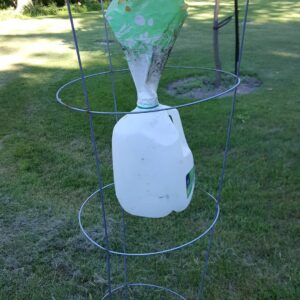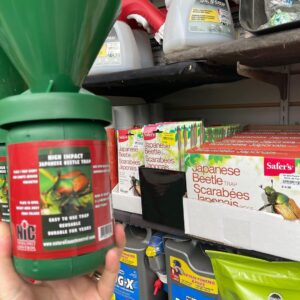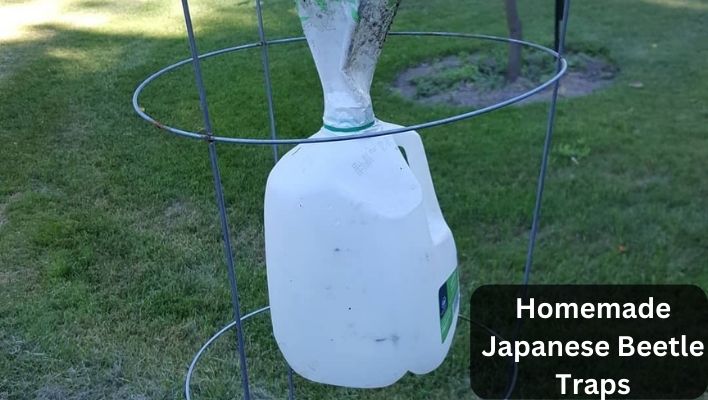Are you tired of battling Japanese beetles in your garden? These voracious insects can wreak havoc on your precious plants, leaving you feeling frustrated and defeated. In this article, we’ll delve into the world of homemade Japanese beetle traps, providing you with effective solutions to regain control of your garden.
Japanese beetles (Popillia japonica) are a common menace that gardeners face. These metallic green insects with bronze wings may be visually appealing, but their appetite for over 300 plant species is far from charming. Roses, grapes, raspberries, and many other beloved garden plants fall victim to their ravenous feeding frenzy.
The importance of using homemade traps for Japanese beetle control cannot be overstated. While there are commercial options available, homemade traps offer several advantages.
First and foremost, they provide an eco-friendly alternative to chemical-laden products, ensuring the well-being of your plants, beneficial insects, and the environment.
Additionally, homemade traps can be customized to suit your garden’s specific needs, increasing their effectiveness.
Below, we’ll explore the mechanics of homemade Japanese beetle traps, walk you through different trap designs, and provide tips for maximizing their efficiency.
Homemade Japanese Beetle Traps: How They Work
Have you ever wondered how homemade Japanese beetle traps work? It’s time to unravel the mystery behind these ingenious devices. The mechanism is quite simple yet effective.
Homemade traps capitalize on the beetles’ instincts and utilize visual cues and enticing scents to lure them in.
The traps typically consist of a container filled with a liquid solution, such as water mixed with liquid soap. This soapy liquid serves two purposes—it drowns the beetles upon contact and reduces the surface tension, making it difficult for them to escape.
One of the significant benefits of homemade traps is their cost-effectiveness. Commercial traps can be pricey, but with a little creativity, you can make your own at a fraction of the cost.
Additionally, homemade traps offer the advantage of customization. You can tailor the design, bait, and placement to suit your garden’s specific needs, enhancing their effectiveness.
Before you embark on building your homemade Japanese beetle trap, there are a few considerations to keep in mind.
- Firstly, choose the right trap design that aligns with your preferences and resources.
- Secondly, identify the most suitable bait options that Japanese beetles find irresistible, such as ripe fruit or fermented concoctions.
- Lastly, strategically place your traps in areas where beetle activity is high, ensuring maximum capture.
Now that you understand the inner workings of homemade Japanese beetle traps and their advantages over commercial options, it’s time to roll up your sleeves and build your very own beetle-busting contraption.

DIY Japanese Beetle Trap Designs
Below, we will introduce you to a range of creative and effective DIY Japanese beetle traps that you can easily make at home.
These traps are designed to attract and capture these pesky invaders, providing you with an organic and environmentally-friendly approach to pest control.
By utilizing readily available materials and following our step-by-step explanations, you can craft your beetle traps, significantly reducing the Japanese beetle population in your garden.
Say goodbye to chemical-laden pesticides and embrace these natural, homemade solutions to protect your plants and restore your garden’s beauty.
Simple Jar Trap Design
Looking for a straightforward yet effective Japanese beetle trap design? Look no further than the simple jar trap. With just a few easy steps, you can create a trap that will lure and capture those pesky beetles. Here’s how:
Step 1: Gather your materials. You’ll need:
- A wide-mouthed jar or container
- Water
- Liquid soap or dish detergent
- A funnel or cone-shaped object
- Bait (e.g., ripe fruit)

Step 2: Fill the jar halfway with water.
Add a few drops of liquid soap or dish detergent. This will break the surface tension and prevent the beetles from escaping.
Step 3: Attach a funnel or cone-shaped object to the mouth of the jar.
This will serve as the entrance for the beetles, allowing them to get in but making it difficult for them to get out.
Step 4: Place a tempting bait, such as a piece of ripe fruit, at the bottom of the jar.
The sweet aroma will attract the Japanese beetles and entice them to enter the trap.
Step 5: Position the trap strategically in your garden.
Place it near plants that are particularly attractive to Japanese beetles. Make sure to monitor the trap regularly and empty it as needed. Traps should not be used at night because Japanese beetles are usually not active during this period.
Remember, maintaining the trap is essential for optimal performance. Empty the captured beetles regularly, as a full jar may deter others from entering. Refill the water and soap solution as necessary to ensure its effectiveness.
By following these simple steps and paying attention to placement and maintenance, you’ll have a powerful tool in your hands to combat Japanese beetles and protect your garden from their destructive appetite.
Bucket Trap Design
If you’re looking for a trap with a larger capacity to catch more Japanese beetles, the bucket trap design is an excellent choice. Follow this detailed guide to build your bucket trap:
Step 1: Gather the materials You’ll need:
- A sturdy bucket or container
- Water
- Liquid soap
- Wire mesh or plastic funnel
- Beetle bait (such as a mixture of fermented fruits or a commercial lure)

Step 2: Prepare the trap
Fill the bucket about halfway with water and add a few drops of liquid soap. The soap will break the water’s surface tension, making it difficult for the beetles to escape.
Step 3: Create the entrance
Attach a wire mesh or plastic funnel to the top of the bucket. This will serve as the entrance for the beetles, guiding them into the trap.
Step 4: Bait the trap
Place the beetle bait near the funnel opening. Japanese beetles are attracted to ripe or rotting fruits, so you can use a mixture of mashed fruits or a commercial lure specifically designed for them.
Step 5: Enhance trap effectiveness
To further increase the trap’s effectiveness, consider the following strategies:
- Position the bucket traps in areas where Japanese beetles are most active, such as near their preferred host plants.
- Add a splash of apple cider vinegar or a small amount of sugar to the water to create an even stronger attractant.
- Regularly empty the trap to prevent overcrowding, as an overcrowded trap may discourage beetles from entering.
By following this guide and implementing these strategies, you’ll be well on your way to capturing Japanese beetles with your homemade bucket trap.
Stay tuned as we explore more DIY trap designs and share additional tips for effective beetle control in your garden.
Other Homemade Trap Variations
In addition to the simple jar trap and bucket trap designs, there are alternative homemade trap variations you can explore. Let’s take a look at some of these options along with their pros and cons:
Bottle Trap Design:
Repurpose plastic bottles to create traps. Cut the top portion of the bottle, invert it, and place it back into the bottom half. Add a bait solution inside the bottle, and the beetles will enter but struggle to find their way out.
Pros:
Easy to make, cost-effective, and captures a significant number of beetles.
Cons:
Requires frequent maintenance and may not be as visually appealing as other designs.
Bag Trap Design:
Hang a mesh or fabric bag in your garden and fill it with a lure or bait that attracts Japanese beetles. As the beetles gather on the bag, you can shake them into a container of soapy water to eliminate them.
Pros:
Simple to set up, captures a large number of beetles, and is easily disposable.
Cons:
Requires active beetle management to transfer them to the soapy water.
Creative Ideas for Repurposing Household Items as Traps
If you’re feeling inventive, you can repurpose everyday household items into effective Japanese beetle traps. Here are some creative ideas:
- Potted Plant Trap: Place a potted plant near your affected plants and attach sticky traps or double-sided tape to the pot. Japanese beetles attracted to the plant will get stuck to the adhesive.
- Dish Soap Spray Trap: Mix water and dish soap in a spray bottle and spray it directly on the beetles. This solution suffocates and immobilizes them, making it easier to collect and dispose of them.
- Light Trap: Set up a bright light near your garden at night. Japanese beetles are attracted to light and will gather around it. You can then use a handheld vacuum or manual collection method to capture them.
These repurposed traps offer unique approaches to combat Japanese beetles using items you may already have at home. Feel free to get creative and adapt these ideas to suit your specific needs and available resources.
With these alternative trap designs and creative repurposing ideas, you have a range of options to combat Japanese beetles and protect your garden. Stay tuned as we delve deeper into homemade solutions to keep your garden free from these pesky invaders.
Tips for Maximizing Homemade Trap Results
To ensure optimal results from your homemade Japanese beetle traps, consider the following tips:
- Proper Placement: Position your traps strategically in areas where Japanese beetle activity is high. Focus on locations near their favored plants or where you have noticed significant damage. This will increase the chances of attracting and capturing more beetles.
- Multiple Traps: Deploy multiple traps throughout your garden rather than relying on a single trap. Japanese beetles can be widespread, and having multiple traps will increase your trapping capacity and overall effectiveness.
- Vary the Bait: Experiment with different bait options to attract a wider range of Japanese beetles. Ripe fruits like peaches or strawberries, fermented concoctions, or commercial lures can be effective choices. You can even try rotating bait options periodically to maintain their allure.
- Regular Maintenance: Check your traps frequently and empty them as needed. Traps that become overcrowded may discourage beetles from entering. Regular maintenance ensures that your traps remain efficient and ready to capture more beetles.
- Monitor and Refill: Keep an eye on the liquid solution in your traps. If it becomes diluted or evaporates, replenish it to maintain its effectiveness. A soapy water solution can drown the beetles upon contact, so it’s important to keep it at the proper level.
- Timing is Key: Be mindful of the timing when deploying your traps. Japanese beetles are most active during the warmer parts of the day, so consider placing the traps in the morning and emptying them in the evening for maximum capture rates.
By following these tips, you can maximize the results of your homemade Japanese beetle traps. Remember, trapping alone may not eliminate Japanese beetle populations, but it can significantly reduce their impact on your garden. Stay vigilant, adapt your strategies as needed, and enjoy the satisfaction of protecting your plants from these persistent pests.
Japanese beetle traps Amazon
If you’re looking for convenient and ready-to-use Japanese beetle traps, Amazon is a great place to explore. With a wide range of options available, you can find traps that suit your specific needs and preferences.
Here are some popular Japanese beetle traps you can find on Amazon:
Rescue Japanese Beetle Trap

The Rescue Japanese Beetle Trap is a highly-rated option on Amazon. It features a dual floral and pheromone lure system to attract beetles from a distance.
This trap comes with a durable bag that can hold a large number of beetles, reducing the need for frequent emptying.
Spectracide Bag-A-Bug Japanese Beetle Trap

The Spectracide Bag-A-Bug Japanese Beetle Trap is another popular choice. It includes a trap, a floral lure, and two disposable bags.
The lure attracts beetles, and once inside the trap, they are captured in the bags for easy disposal. This trap is designed to target Japanese beetles specifically.
Bonide Beetle Bagger Japanese Beetle Trap

The Bonide Beetle Bagger Japanese Beetle Trap offers an effective solution for beetle control. It includes a dual lure system, a trap, and a disposable bag.
The lures attract the beetles, and the bag captures them for disposal. This trap is known for its simplicity and effectiveness.
When shopping on Amazon, be sure to read customer reviews, compare prices, and check for any additional accessories or replacement parts that may be needed for the trap. With the convenience of online shopping, you can have your Japanese beetle traps delivered right to your doorstep, saving you time and effort.
Remember, while commercial traps can be effective, homemade traps provide an eco-friendly and customizable alternative. Consider the pros and cons of both options and choose the one that best fits your garden’s needs and your personal preferences.
Japanese beetle traps homemade FAQs
Can homemade Japanese beetle traps control the population?
Homemade Japanese beetle traps can be effective in reducing Japanese beetle populations in your garden. While they may not completely eradicate the population, they can significantly minimize the damage caused by these pests.
Traps capitalize on the beetles’ instincts and lure them in, capturing and eliminating a substantial number of beetles.
However, it’s important to note that trapping alone may not completely control the population, as beetles from neighboring areas can still migrate into your garden.
It’s recommended to use a combination of trapping, manual removal, and other pest management strategies for more comprehensive control.
What is the best bait to attract Japanese beetles?
Japanese beetles are attracted to a variety of scents and flavors, so there are several bait options you can use in your homemade traps. Ripe fruits such as peaches, strawberries, or grapes are popular choices.
You can also create a mixture of fermented fruits or use commercially available lures designed specifically for attracting Japanese beetles.
Experiment with different baits to determine which works best in your garden, and consider rotating or refreshing the bait periodically to maintain its effectiveness.
How often should I empty and clean the traps?
The frequency of emptying and cleaning your homemade traps depends on the level of beetle activity and the trap’s capacity.
As a general guideline, check the traps at least once every two to three days, especially during peak beetle season. If the traps become overcrowded, empty them more frequently to prevent beetles from escaping or deter other beetles from entering.
Cleaning the traps is essential to maintain their efficiency. Rinse them with water and a mild detergent, and replace the liquid solution to ensure it remains effective in drowning the captured beetles.
Can homemade traps attract beneficial insects too?
Homemade traps primarily target Japanese beetles, but some beneficial insects may also be attracted to the traps.
While the traps are designed to lure and capture Japanese beetles specifically, there is a chance that other insects may get caught as well.
To minimize the capture of beneficial insects, it’s recommended to strategically place the traps away from areas where beneficial are most active, such as pollinator gardens or areas with high ladybug populations.
Regular monitoring and inspection of the traps will also allow you to release any beneficial insects inadvertently caught.
Are there any risks associated with homemade traps?
Homemade traps are generally safe and pose minimal risks when used correctly. However, it’s essential to follow proper handling and disposal practices.
Avoid contact with the soapy water or bait mixture, as they can be harmful if ingested or irritate the skin or eyes.
Dispose of captured beetles by either drowning them in a bucket of soapy water or sealing them in a plastic bag before discarding them.
Keep the traps away from children and pets to prevent accidental contact. Additionally, while homemade traps are effective in capturing Japanese beetles, they may not provide complete control, and other integrated pest management methods may be necessary to address the beetle problem comprehensively.
Conclusion
Homemade Japanese beetle traps are a practical and cost-effective solution for controlling Japanese beetle populations in your garden. While they may not eliminate the pests, these traps can significantly reduce their numbers and minimize the damage they cause to your plants.
By constructing and strategically placing homemade traps, you can take advantage of the beetles’ instincts and lure them into the traps.
Whether you choose a simple jar trap, a bucket trap, or explore alternative designs, the key is to provide enticing bait and maintain the traps regularly.
It’s important to remember that trapping alone may not be sufficient for complete population control. Consider combining homemade traps with other pest management strategies, such as handpicking beetles, applying organic insecticides, or using physical barriers, to achieve more comprehensive results.
While homemade traps are effective, it’s also worth exploring commercial trap options available on platforms like Amazon.
With homemade Japanese beetle traps, patience, and consistent monitoring, you can effectively manage Japanese beetle populations and safeguard your precious plants.
Enjoy the process of creating and refining your traps, and embrace the satisfaction of preserving the beauty and health of your garden.
